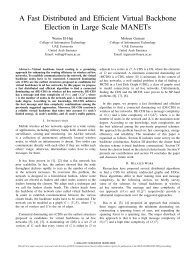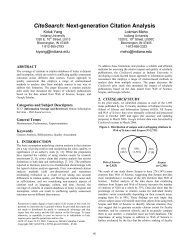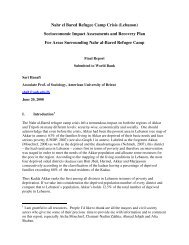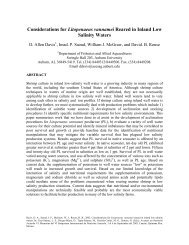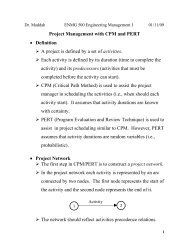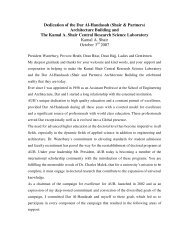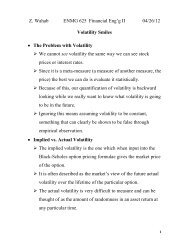E-mail interviewing in qualitative research: A methodological ... - E-LIS
E-mail interviewing in qualitative research: A methodological ... - E-LIS
E-mail interviewing in qualitative research: A methodological ... - E-LIS
Create successful ePaper yourself
Turn your PDF publications into a flip-book with our unique Google optimized e-Paper software.
TABLE 1. (cont<strong>in</strong>ued)Geographical Length of No. of e-<strong>mail</strong>No. of e-<strong>mail</strong> No. of FTF distribution of Recruitment Interview e-<strong>mail</strong> data or follow-up Participation/participants participants Participants participants tool/method questions collection period exchanges Incentives dropout ratesKim et al. (2003)Meho & Tibbo(2003)Hodgson (2004)Lehu (2004)Murray (2004)Murray &Harrison (2004)Olivero & Lunt(2004)10(3 women and7 men)60(19 women and41 men)22(18 women and4 men)532119 women and 16men5(4 women and1 men)23(12 women and 11men)None5(all men)NoneNone1419 women and 16men5(2 women and3 men)5College studentsFacultySelf-reported self<strong>in</strong>jurersExecutivesSuccessfulprosthesis usersStroke survivorsWeb and e-<strong>mail</strong>usersMid-Atlantic states14 differentcountriesDifferent states <strong>in</strong>the United StatesFranceUnited K<strong>in</strong>gdom[and possiblyother countries]United K<strong>in</strong>gdom[and possiblyother countries]Different regions<strong>in</strong> the UnitedK<strong>in</strong>gdomPsychologycourseDatabasesearch<strong>in</strong>g toidentify e-<strong>mail</strong>addresses andthen <strong>in</strong>dividual<strong>in</strong>vitationsMessage boardsTelephone ande-<strong>mail</strong>Advertisement onan e-<strong>mail</strong> discussiongroup (withapproximately 200members) via themoderator of thelistE-<strong>mail</strong> discussiongroup for strokesurvivorsSnowball<strong>in</strong>gamongexperiencedInternet and e-<strong>mail</strong> usersInterview Guide<strong>in</strong> a s<strong>in</strong>gle e-<strong>mail</strong>and follow-upInterview Guide<strong>in</strong> a s<strong>in</strong>gle e-<strong>mail</strong>and follow-upInterview Guide<strong>in</strong> a s<strong>in</strong>gle e-<strong>mail</strong>and follow-upInterview Guide<strong>in</strong> a s<strong>in</strong>gle e-<strong>mail</strong>and follow-upBuild<strong>in</strong>g rapportand provid<strong>in</strong>g aprovisionalstructure to the<strong>in</strong>terview first,then a few questionsat a timeBuild<strong>in</strong>g rapportand provid<strong>in</strong>g aprovisionalstructure to the <strong>in</strong>terviewfirst, then afew questions at atimeBuild<strong>in</strong>g rapportand provid<strong>in</strong>g aprovisional structureto the <strong>in</strong>terviewfirst, then afew questions ata time10 weeks5 monthsOver a month2–5 weeks2–6 monthsAn average of 6weeks (range 2–8weeks)Over 6 weeksSeveral75.0% of studyparticipantsreplied to 1–3follow-up e-<strong>mail</strong>s2–9 follow-upe-<strong>mail</strong>s perparticipantA maximum of 2follow-upexchanges withmost participants;only 7 had moreexchangesOn average, 15contacts weremade per person(range: 5–60contacts)On average, 8.4contacts weremade per person(range: 8–10)Ranged from17–24 messagesper participantCourse creditBibliograph.&citation searches,and copies ofarticlesNRNRNRNR20 pounds, 10pounds if e-<strong>mail</strong>swere answeredwith<strong>in</strong> 24 hours2 students droppedout dur<strong>in</strong>g datacollection and datafrom 5 studentswere not used, to<strong>in</strong>crease thehomogeneity ofthe sampleOf 106 potentialparticipants, 16decl<strong>in</strong>ed for lackof time and 30 didnot respond to the<strong>in</strong>vitationsExecutives at 92firms were contacted.56 agreedto participate. 53were acceptedNRNRNRNote. FTF face-to-face; NR not reported.JOURNAL OF THE AMERICAN SOCIETY FOR INFORMATION SCIENCE AND TECHNOLOGY—August 2006 1287DOI: 10.1002/asi
ight to withdraw from a study at any time is also <strong>in</strong>cluded <strong>in</strong>the consent form. For more details about <strong>in</strong>formed consent<strong>in</strong> onl<strong>in</strong>e <strong>research</strong>, see Kraut et al. (2004).Accord<strong>in</strong>g to Kraut et al. (2004), “<strong>research</strong> on the Internetis not <strong>in</strong>herently more difficult to conduct or <strong>in</strong>herentlyriskier to subjects than more traditional <strong>research</strong> styles. Butbecause the Internet is a relatively new medium for conduct<strong>in</strong>g<strong>research</strong>, it raises ambiguities that have been long settled<strong>in</strong> more conventional laboratory and field sett<strong>in</strong>gs” (p. 114).In address<strong>in</strong>g these issues, <strong>research</strong>ers and InstitutionalReview Boards (IRBs) will need expertise, which manycurrently lack. 3 This <strong>in</strong>cludes expertise about both onl<strong>in</strong>ebehavior and technology. For example, security, digital signatures,procedures for stripp<strong>in</strong>g identify<strong>in</strong>g <strong>in</strong>formation,and provisions for one-on-one debrief<strong>in</strong>g require specializedtechnical expertise. As <strong>in</strong> the case of face-to-face <strong>research</strong>, <strong>in</strong>the context of e-<strong>mail</strong> <strong><strong>in</strong>terview<strong>in</strong>g</strong> <strong>research</strong>ers need to ensurethat adequate provisions are taken to protect the privacy ofparticipants and to ma<strong>in</strong>ta<strong>in</strong> the confidentiality of data. Thisis so because identify<strong>in</strong>g <strong>in</strong>formation such as records ofstatements, attitudes, or behaviors, coupled with names, e-<strong>mail</strong> addresses, partially disguised pseudonyms, or otheridentify<strong>in</strong>g <strong>in</strong>formation, may be <strong>in</strong>advertently disclosed eitherwhen the data are be<strong>in</strong>g collected or, more commonly,when they are stored on a networked computer connected tothe public Internet (Kraut et al., 2004; S<strong>in</strong>ger & Lev<strong>in</strong>e,2003). Emphasiz<strong>in</strong>g to participants that certa<strong>in</strong> measureswill be adopted to maximize confidentiality is necessary. Examplesof these measures <strong>in</strong>clude the use of pseudonyms andhid<strong>in</strong>g the user names, doma<strong>in</strong> names, and any other personalidentifiers when publish<strong>in</strong>g or stor<strong>in</strong>g <strong>in</strong>terview data.Many people perceive onl<strong>in</strong>e communication as anonymousbecause there is no <strong>in</strong>-person contact and thus, littleaccountability. This anonymity may expla<strong>in</strong> why some peopleare more will<strong>in</strong>g to participate <strong>in</strong> e-<strong>mail</strong> <strong>in</strong>terview studies,whereas others are more will<strong>in</strong>g to stop participat<strong>in</strong>g, not respond<strong>in</strong> a timely fashion, embellish more, or be less friendlyto the <strong>in</strong>terviewer (Hodgson, 2004; Mann & Stewart, 2000).As expla<strong>in</strong>ed further below, the anonymity afforded by onl<strong>in</strong>ecommunication can be an important factor <strong>in</strong> <strong>in</strong>creas<strong>in</strong>gself-disclosure (Herr<strong>in</strong>g, 1996; Mann & Stewart; Tidwell &Walther, 2002) and <strong>in</strong> facilitat<strong>in</strong>g a closer connection with <strong>in</strong>terviewees’personal feel<strong>in</strong>gs, beliefs, and values (Matheson,1992). The American Psychological Association (Kraut et al.,2004), the American Association for the Advancement of Science(Frankel & Siang, 1999), the Association of InternetResearch (Ess, 2002), Brownlow and O’Dell (2002), Eysenbachand Till (2001), Mann and Stewart (2000), Pittenger(2003), and Sharf (1999) all provide excellent detaileddiscussion on ethical issues relevant to onl<strong>in</strong>e <strong>research</strong>.3 The American Psychological Association (APA) recommends that allIRB boards have technical consultants who can be called on to resolve theseissues when needed. APA further recommends that IRBs undertake an educationalmission to <strong>in</strong>form <strong>research</strong>ers about the issues, the judgments thatare now <strong>in</strong>volved, and remedies for ensur<strong>in</strong>g the health and protection ofsubjects <strong>in</strong> onl<strong>in</strong>e <strong>research</strong> (Kraut et al., 2004).Medium EffectsOne of the most important differences between e-<strong>mail</strong> <strong>in</strong>terviewsand face-to-face or telephone <strong>in</strong>terviews <strong>in</strong>volvesmedia richness, that is, the ability of a communicationmedium to foster <strong>in</strong>teraction and feedback and to permitpeople to communicate with many k<strong>in</strong>ds of cues, us<strong>in</strong>g multiplesenses (Panteli, 2002; Robert & Dennis, 2005). Hav<strong>in</strong>gsaid this, face-to-face <strong>in</strong>terviews are then expected to providericher data than telephone <strong>in</strong>terviews and telephone<strong>in</strong>terviews are expected to provide richer data than e-<strong>mail</strong><strong>in</strong>terviews (Schneider et al., 2002). This is true because <strong>in</strong>e-<strong>mail</strong> <strong>in</strong>terviews, for example, the <strong>in</strong>terviewer will not beable to read facial expressions and body language, make eyecontact, or hear voice tones of the participants. As a result, itis possible that some important visual or nonverbal cues aremissed onl<strong>in</strong>e that would be observed dur<strong>in</strong>g face-to-facedata collection (Selwyn & Robson, 1998).On the other hand, e-<strong>mail</strong> <strong>in</strong>terviews reduce, if not elim<strong>in</strong>ate,some of the problems associated with telephone orface-to-face <strong>in</strong>terviews, such as the <strong>in</strong>terviewer/<strong>in</strong>tervieweeeffects that might result from visual or nonverbal cues or statusdifference between the two (e.g., race, gender, age, voicetones, dress, shyness, gestures, disabilities). Murray andHarrison (2004), for example, argue that some of their potentialparticipants—stroke survivors—were assumed not to beable or will<strong>in</strong>g to take part <strong>in</strong> face-to-face <strong>in</strong>terviews becauseof speech and mobility disabilities or self-consciousnessabout their appearance. Kim et al. (2003), too, expla<strong>in</strong> that,among other th<strong>in</strong>gs, e-<strong>mail</strong> may safeguard aga<strong>in</strong>st possibleloss of face among some people when they describe potentiallysensitive events, experiences, or personal characteristics(e.g., difficult relationships with family, lack of Englishproficiency, racism, academic problems), thus allow<strong>in</strong>gthem to participate <strong>in</strong> <strong>research</strong> studies. In short, <strong>in</strong> manycases e-<strong>mail</strong> facilitates greater disclosure of personal <strong>in</strong>formation,offer<strong>in</strong>g further benefits to both the <strong>research</strong>er andparticipants (Bowker & Tuff<strong>in</strong>, 2004).Another medium-related problem <strong>in</strong> e-<strong>mail</strong> <strong><strong>in</strong>terview<strong>in</strong>g</strong>is that it is always possible that some participants may not beas effective writers as they are speakers (Karchmer, 2001).As mentioned earlier, however, the opposite could be true,too. There could be some participants (and even <strong>in</strong>terviewers)who do not or cannot express themselves as well <strong>in</strong> talk<strong>in</strong>gas they do <strong>in</strong> writ<strong>in</strong>g. Onl<strong>in</strong>e communication could solvethe latter problem because neither the participants nor the<strong>in</strong>terviewers need to communicate orally or face-to-face.Acknowledg<strong>in</strong>g that e-<strong>mail</strong> has strengths and weaknessesas a communication medium, <strong>research</strong>ers strive to maximizethe richness of the tool by employ<strong>in</strong>g certa<strong>in</strong> l<strong>in</strong>guistic methods,such as the use of acronyms or abbreviations (e.g.,LOL, laugh<strong>in</strong>g out loud; ROFL, roll<strong>in</strong>g on the floor laugh<strong>in</strong>g)and emoticons (e.g., those little smiley faces), as well asunderl<strong>in</strong><strong>in</strong>g and capitalization (for emphasis), as a substitutefor nonverbal cues (Walther, Anderson, & Park, 1994). Becauselittle is known about the number of e-<strong>mail</strong> users whoare literate with these communication methods, it isJOURNAL OF THE AMERICAN SOCIETY FOR INFORMATION SCIENCE AND TECHNOLOGY—August 2006 1289DOI: 10.1002/asi
important for <strong>research</strong>ers who use e-<strong>mail</strong> <strong><strong>in</strong>terview<strong>in</strong>g</strong> as adata collection method to <strong>in</strong>struct and encourage their participantsto use such acronyms and emoticons. This will notonly lessen some of the losses <strong>in</strong> nonverbal cues but itshould also <strong>in</strong>crease the depth of the data collected.Interview QuestionsAs <strong>in</strong> face-to-face and telephone <strong>in</strong>teractions, moste-<strong>mail</strong> <strong>in</strong>terview-based studies use an <strong>in</strong>terview schedule fordata collection. Some <strong>research</strong>ers decompose the schedule<strong>in</strong>to several sections and ask a certa<strong>in</strong> number of questions atone time, whereas others send all primary <strong>in</strong>terview questions<strong>in</strong> one e-<strong>mail</strong> message (see Table 1). Moreover, some<strong>research</strong>ers e-<strong>mail</strong> their questions only after secur<strong>in</strong>gpermission from their participants. Others e-<strong>mail</strong> their <strong>in</strong>terviewquestions along with the <strong>in</strong>terview <strong>in</strong>vitation and consentform so that potential participants will have a better ideaof what would be <strong>in</strong>volved <strong>in</strong> the <strong>in</strong>terview process beforeany commitments are made.The lack of a standard for conduct<strong>in</strong>g e-<strong>mail</strong> <strong>in</strong>terviews isdue to variations <strong>in</strong> the length of an <strong>in</strong>terview schedule, thecharacteristics of the target population, and the experiencesof the <strong>research</strong>ers <strong>in</strong> conduct<strong>in</strong>g <strong>qualitative</strong> e-<strong>mail</strong> <strong>in</strong>terviews.With the exception of Meho and Tibbo (2003), no <strong>research</strong>report explicitly expla<strong>in</strong>ed why one method was usedbut not another. In their case, a pretest was conducted to determ<strong>in</strong>ewhich method was best for their participants. Theresult <strong>in</strong>dicated that all <strong>in</strong>terview materials could be sent together<strong>in</strong> one e-<strong>mail</strong>, <strong>in</strong>clud<strong>in</strong>g the <strong>in</strong>vitation for participation,background <strong>in</strong>formation about the <strong>research</strong>ers, consentform, <strong>in</strong>structions, and the <strong>in</strong>terview schedule. This strategymay not be appropriate with other populations. The po<strong>in</strong>there, however, is that pretests help determ<strong>in</strong>e the bestmethod for each <strong>in</strong>dividual study or group of participants.Meho and Tibbo (2003), as well as other <strong>research</strong>ers suchas Curasi (2001) found that the <strong>in</strong>terview guide conta<strong>in</strong><strong>in</strong>gthe <strong>in</strong>terview questions could be sent to <strong>in</strong>formants via e-<strong>mail</strong>with the questions embedded <strong>in</strong> the e-<strong>mail</strong> message, ratherthan <strong>in</strong> an attached document. Research has shown that embeddedquestions result <strong>in</strong> significantly higher response rates(five times as much) than do those attached to an e-<strong>mail</strong> message(Dommeyer & Moriarty, 2000). This is because the attachede-<strong>mail</strong> questions present too many obstacles to the potentialrespondent. Anyone respond<strong>in</strong>g to an attached e-<strong>mail</strong>survey must have: a strong <strong>in</strong>terest <strong>in</strong> respond<strong>in</strong>g; the hardwareand software that will enable him/her to download,read, and upload a foreign file; the knowledge of how to executethe various response steps; and a low fear of computerviruses. Absence of any one of these could result <strong>in</strong> a nonresponse.The embedded e-<strong>mail</strong> survey, despite its formatt<strong>in</strong>glimitations, can be answered and returned by the most unsophisticatedof e-<strong>mail</strong> users and therefore can appeal to abroader audience (Dommeyer & Moriarty).A dist<strong>in</strong>ctive feature <strong>in</strong> e-<strong>mail</strong> <strong><strong>in</strong>terview<strong>in</strong>g</strong> is that it allowsparticipants to take their time <strong>in</strong> answer<strong>in</strong>g questionsand to take part <strong>in</strong> the <strong>in</strong>terviews <strong>in</strong> a familiar environment(e.g., home or office), which may make them feel more relaxedexpress<strong>in</strong>g themselves and <strong>in</strong> respond<strong>in</strong>g when andhow they feel comfortable (Kennedy, 2000; Lehu, 2004).Although this may generate rich and high quality data, it alsomeans that the e-<strong>mail</strong>ed questions must be much more selfexplanatorythan those posed face-to-face, with a clear <strong>in</strong>dicationgiven of the responses required. Even when questionsare pretested, because of lack of face-to-face or direct <strong>in</strong>teraction<strong>in</strong> e-<strong>mail</strong> <strong>in</strong>terviews, there is always room formiscommunication and mis<strong>in</strong>terpretation. The <strong>in</strong>clusion ofadditional <strong>in</strong>formation may, however, function to narrowparticipants’ <strong>in</strong>terpretations and, thereby, constra<strong>in</strong> theirresponses. Therefore, manag<strong>in</strong>g this <strong>methodological</strong>dilemma requires meticulous attention to detail, with attemptsto reduce ambiguity and improve specificity whileavoid<strong>in</strong>g the narrow<strong>in</strong>g of participants’ <strong>in</strong>terpretations andconstra<strong>in</strong>t of their responses. Accord<strong>in</strong>g to Bowker andTuff<strong>in</strong> (2004), restrict<strong>in</strong>g some of the ideas chosen for analysiswill be <strong>in</strong>evitable, but it is very important and necessaryto m<strong>in</strong>imize participants’ confusion and eventual frustrationby specify<strong>in</strong>g the mean<strong>in</strong>g of <strong>in</strong>terview questions. Thefollow<strong>in</strong>g two examples from Meho and Tibbo’s study(2003) demonstrate cases for which additional explanationof questions is needed:Interview Question: Who and when do you usually askfor help <strong>in</strong> locat<strong>in</strong>g <strong>research</strong> <strong>in</strong>formation? For whatk<strong>in</strong>d(s) of help do you normally ask?Participant Answer: I don’t know what you mean here. Iusually hire a graduate student to do some basic legworkfor me <strong>in</strong> terms of hunt<strong>in</strong>g out the newest <strong>in</strong>formation onwhatever subject I am work<strong>in</strong>g on at the time.Interview Question: What criteria do you employ whenassess<strong>in</strong>g whether to follow up on materials not found <strong>in</strong>your university library?Participant Answer: Don’t know what you mean by this.The fact that these two questions were not clear to, orwere mis<strong>in</strong>terpreted by, only a very small fraction of thestudy participants (3.3%) suggests that additional explanationor follow-up on mis<strong>in</strong>terpreted questions be provided onan <strong>in</strong>dividual basis rather than to all participants. This shouldespecially be the case when such questions are <strong>in</strong>terpretedcorrectly by the majority of the study participants.ProbesProbes or follow-up questions <strong>in</strong> <strong>in</strong>terviews are generallyused to elaborate and clarify participants’ responses or tohelp elicit additional <strong>in</strong>formation and depth from <strong>in</strong>formants.Unlike face-to-face and telephone <strong>in</strong>terviews, e-<strong>mail</strong><strong>in</strong>terviews do not allow direct prob<strong>in</strong>g; it can be done only <strong>in</strong>follow-up e-<strong>mail</strong>s, which can take place any time dur<strong>in</strong>g thedata collection and analysis periods.The lack of direct prob<strong>in</strong>g <strong>in</strong> e-<strong>mail</strong> <strong>in</strong>terviews may result<strong>in</strong> miss<strong>in</strong>g some important pieces of data, especially giventhat not all participants respond to follow-up questions, evenif they were told to expect them. In Kennedy’s study (2000),1290 JOURNAL OF THE AMERICAN SOCIETY FOR INFORMATION SCIENCE AND TECHNOLOGY—August 2006DOI: 10.1002/asi
for example, 23 participants were <strong>in</strong>itially <strong>in</strong>volved; yet 3stopped communicat<strong>in</strong>g after the first set of questions wereanswered and 3 did not supply enough <strong>in</strong>formation for analysis.In Karchmer’s study (2001), 16 <strong>in</strong>itially agreed to participate,but 3 discont<strong>in</strong>ued correspondence with<strong>in</strong> the firstweek of data collection. In Meho and Tibbo’s (2001) study,15 of the 60 study participants term<strong>in</strong>ated the <strong>in</strong>terviewprocess and did not answer any of the follow-up questions.There are, however, cases <strong>in</strong> which all participants respondedto follow-up probes, such as <strong>in</strong> Curasi’s (2001) study.As expected by <strong>research</strong>ers, the lack or loss of communicationafter the <strong>in</strong>itial <strong>in</strong>terview can be frustrat<strong>in</strong>g (Hodgson,2004), but <strong>in</strong> none of the studies reviewed here was therediscussion of this problem or an <strong>in</strong>dication that this loss hadany impact on the quality of data collected. In fact, althoughthe lack of direct prob<strong>in</strong>g may result <strong>in</strong> the loss of some importantpieces of <strong>in</strong>formation, on the other hand, it can playa major role <strong>in</strong> improv<strong>in</strong>g the quality of the e-<strong>mail</strong> <strong>in</strong>terviewdata (Lehu, 2004). This is because the <strong>research</strong>er is not limitedto the probes that come to m<strong>in</strong>d dur<strong>in</strong>g the face-to-face<strong>in</strong>terviews and because it gives participants ample time toth<strong>in</strong>k about their answers before send<strong>in</strong>g them (Curasi,2001). The benefits of <strong>in</strong>direct prob<strong>in</strong>g are further discussed<strong>in</strong> the follow<strong>in</strong>g section.Data QualityAccord<strong>in</strong>g to Denscombe (2003, p. 51), the quality of responsesga<strong>in</strong>ed through onl<strong>in</strong>e <strong>research</strong> is much the same asresponses produced by more traditional methods. The sameconclusion was reached <strong>in</strong> several studies that compared, orconducted, both e-<strong>mail</strong> and face-to-face <strong>in</strong>terviews (e.g.,Curasi, 2001; Meho & Tibbo, 2003; Murray, 2004; Murray& Harrison, 2004). These studies found that participants<strong>in</strong>terviewed via e-<strong>mail</strong> rema<strong>in</strong>ed more focused on the <strong>in</strong>terviewquestions and provided more reflectively denseaccounts than their face-to-face counterparts. This is not tosay that the quality of face-to-face <strong>in</strong>terviews is lower, butrather to highlight the benefits of the e-<strong>mail</strong> <strong>in</strong>terview, whichwas possibly aided by the ability of both the <strong>research</strong>ersand the <strong>in</strong>terviewees to take the time to be more thoughtfuland careful <strong>in</strong> their responses to, or communication with,each other than they would dur<strong>in</strong>g natural conversation(Karchmer, 2001; Murray, 2004; Young et al., 1998).Data quality, accord<strong>in</strong>g to Curasi (2001), is dependent onwho is be<strong>in</strong>g <strong>in</strong>terviewed, who the <strong>in</strong>terviewers are, and howskillful they are <strong>in</strong> onl<strong>in</strong>e <strong><strong>in</strong>terview<strong>in</strong>g</strong>. She found, forexample, that some e-<strong>mail</strong> <strong>in</strong>terview participants providedvery short and very precise responses to the questions posed.Others, however, discussed at length their feel<strong>in</strong>gs andexperiences, sometimes <strong>in</strong> as much depth and detail as theirface-to-face counterpart, especially when data from the<strong>in</strong>itial questions are comb<strong>in</strong>ed with those from follow-upquestions. In other studies, data from face-to-face <strong>in</strong>terviewsdid not reveal any <strong>in</strong>formation that was not already discoveredvia data from e-<strong>mail</strong> <strong>in</strong>terviews (Meho & Tibbo, 2003).Still other studies found that much of the <strong>in</strong>formationconveyed through electronic <strong>mail</strong> is <strong>in</strong>formation that wouldnot be conveyed through another medium, such as sensitiveand personal <strong>in</strong>formation—health, medical, political, and soon (Beck, 2005; Murray & Sixsmith, 1998).Overall, e-<strong>mail</strong> <strong><strong>in</strong>terview<strong>in</strong>g</strong> offers an opportunity to access,<strong>in</strong> an <strong>in</strong>teractive manner, participants’ thoughts, ideas,and memories <strong>in</strong> their own words. It allows the record<strong>in</strong>gof many anecdotes that participants share to enhance theaccounts of their experiences. It also allows participants toconstruct their own experiences with their own dialogueand <strong>in</strong>teraction with the <strong>research</strong>er. E-<strong>mail</strong> <strong><strong>in</strong>terview<strong>in</strong>g</strong> isadditionally empower<strong>in</strong>g to the participants because itessentially allows them to be <strong>in</strong> control of the flow of the<strong>in</strong>terview (Bowker & Tuff<strong>in</strong>, 2004), enabl<strong>in</strong>g them to answerat their convenience and <strong>in</strong> any manner they feel suitable(Kennedy, 2000). Lev<strong>in</strong>son (1990) considers that the asynchronouselectronic communication’s capacity to provideopportunity for reflection and edit<strong>in</strong>g of messages before send<strong>in</strong>gthem contributes to the production of a closer fit betweenideas, <strong>in</strong>tentions, and their expression <strong>in</strong> writ<strong>in</strong>g. A summaryof the advantages and disadvantages of e-<strong>mail</strong> <strong><strong>in</strong>terview<strong>in</strong>g</strong>, orchallenges associated with it, is provided <strong>in</strong> Table 2.Guidel<strong>in</strong>es for Conduct<strong>in</strong>g EffectiveE-Mail InterviewsIn addition to the f<strong>in</strong>d<strong>in</strong>gs discussed above, the studiesreviewed or exam<strong>in</strong>ed <strong>in</strong> this article and the personal experienceof the author offer several suggestions for those consider<strong>in</strong>gthe use of e-<strong>mail</strong> <strong>in</strong>terviews <strong>in</strong> <strong>qualitative</strong> <strong>research</strong>.These suggestions are presented here <strong>in</strong> order to assist<strong>research</strong>ers <strong>in</strong> conduct<strong>in</strong>g more efficient and effective e-<strong>mail</strong><strong>in</strong>terviews, as well as to enable them to establish trustworthyresults:• Invitations: Solicit people for participation <strong>in</strong>dividually ifpossible rather than via a <strong>mail</strong><strong>in</strong>g list or message board.Accord<strong>in</strong>g to Dillman (2000), this technique shows potentialparticipants that they are important, thereby encourag<strong>in</strong>gthem to participate.• Subject l<strong>in</strong>e: Use an effective subject l<strong>in</strong>e for the first contactwith the <strong>in</strong>terviewees, such as Research Interview. Thiswill avoid or reduce the likelihood of a request be<strong>in</strong>g deletedbefore it is read.• Self-disclosure: Introduce yourself and provide brief <strong>in</strong>formationabout your professional status/credentials. Then tellyour <strong>in</strong>terviewees how you acquired their e-<strong>mail</strong> addresses.This will help to establish trust. There is evidence thatpeople will engage <strong>in</strong> more self-disclosure when they firstbecome recipients of such self-disclosure from their <strong>in</strong>terviewers(Moon, 2000).• Interview request: State your request succ<strong>in</strong>ctly and professionally,as<strong>in</strong>“MayI<strong>in</strong>terviewyouforanarticleIamwrit<strong>in</strong>g?”• Be open about the <strong>research</strong>: Suspicion can exist when onl<strong>in</strong>e<strong>research</strong>ers contact participants. One way to establishtrust that creates rapport is to be as open as possible aboutthe purposes and processes of the <strong>research</strong>. Outl<strong>in</strong>e thedetails of the project and specify the topic of the <strong>in</strong>terviewand the <strong>in</strong>terview procedure, <strong>in</strong>clud<strong>in</strong>g <strong>in</strong>formation aboutJOURNAL OF THE AMERICAN SOCIETY FOR INFORMATION SCIENCE AND TECHNOLOGY—August 2006 1291DOI: 10.1002/asi
TABLE 2.Advantages/disadvantages of e-<strong>mail</strong> <strong><strong>in</strong>terview<strong>in</strong>g</strong>.Interviewers andparticipantsCostTimeRecruitmentParticipationMediumeffectsAllows access to <strong>in</strong>dividuals often difficult or impossible toreach or <strong>in</strong>terview face-to-face or via telephoneAllows access to diverse <strong>research</strong> subjectsAllows access to <strong>in</strong>dividuals regardless of theirgeographic locationAllows <strong><strong>in</strong>terview<strong>in</strong>g</strong> of <strong>in</strong>dividuals who do not or cannotexpress themselves as well <strong>in</strong> talk<strong>in</strong>g as they do <strong>in</strong> writ<strong>in</strong>gAllows <strong><strong>in</strong>terview<strong>in</strong>g</strong> of <strong>in</strong>dividuals who prefer onl<strong>in</strong>e<strong>in</strong>teraction over face-to-face or telephone conversationElim<strong>in</strong>ates expenses of call<strong>in</strong>g and travel<strong>in</strong>gElim<strong>in</strong>ates expenses of transcrib<strong>in</strong>gDecreases cost of recruit<strong>in</strong>g large/geographicallydispersed samplesElim<strong>in</strong>ates time required for transcrib<strong>in</strong>gElim<strong>in</strong>ates the need to schedule appo<strong>in</strong>tmentsAllows <strong><strong>in</strong>terview<strong>in</strong>g</strong> more than 1 participant at a timeDone via e-<strong>mail</strong>, listservs, message boards, discussion groups,and/or Web pagesDone by e-<strong>mail</strong>AdvantagesAllows participants to take part <strong>in</strong> the <strong>in</strong>terviews <strong>in</strong> a familiarenvironment (e.g., home or office)Limited to <strong>in</strong>dividuals with access to the InternetRequires skills <strong>in</strong> onl<strong>in</strong>e communication from both <strong>in</strong>terviewerand <strong>in</strong>tervieweesRequires expertise <strong>in</strong> technology from both <strong>in</strong>terviewer and<strong>in</strong>tervieweesCan be high for participantsDisadvantages/ChallengesMay take several days or weeks before an <strong>in</strong>terview iscompleteInvitations for participation may be deleted before theyare readHigh undeliverable rates (e.g., due to <strong>in</strong>active e-<strong>mail</strong>addresses)Some participants may drop out before <strong>in</strong>terview is completeEmpowers participants, essentially allow<strong>in</strong>g them to be <strong>in</strong>control of the flow of the <strong>in</strong>terviewAllows participants to take their time <strong>in</strong> answer<strong>in</strong>g questions Does not allow direct prob<strong>in</strong>gAllows participants to express their op<strong>in</strong>ions and feel<strong>in</strong>gs morehonestly (because of sense of anonymity)Encourages self-disclosureElim<strong>in</strong>ates <strong>in</strong>terruption that takes place <strong>in</strong>face-to-face/telephone <strong>in</strong>terviewsElim<strong>in</strong>ates transcription errorsElim<strong>in</strong>ates <strong>in</strong>terviewer/<strong>in</strong>terviewee effect result<strong>in</strong>g from visualand nonverbal cues or status difference between the two(e.g., race, gender, age, voice tones, dress, gestures, disabilities) Requires meticulous attention to detailCues and emotions can be conveyed through use of certa<strong>in</strong> Participants may lose focussymbols or textRequires that questions be more self-explanatory thanthose posed face-to-face or by telephone, to avoidmiscommunication and mis<strong>in</strong>terpretationLoses visual and nonverbal cues due to <strong>in</strong>ability to read facialexpressions or body languages or hear the voice tones ofeach otherMay narrow participants’ <strong>in</strong>terpretations and, thereby,constra<strong>in</strong> their responsesData qualityAllows participants to construct their own experiences withtheir own dialogue and <strong>in</strong>teraction with the <strong>research</strong>erFacilitates a closer connection with <strong>in</strong>terviewee’s personalfeel<strong>in</strong>gs, beliefs, and valuesData are more focused on the <strong>in</strong>terview questions askedResponses are more thought out before they are sentOne-dimensional (based on text only)In-depth <strong>in</strong>formation is not always easily obta<strong>in</strong>ablefollow-up exchanges. It is important that participants knowwhat types of questions to expect, how much time is requiredfor participation, and how many times they will becontacted. Made aware of this <strong>in</strong>formation, potential <strong>in</strong>tervieweeswill likely make more <strong>in</strong>formed decisions onwhether to participate, which will assure better cont<strong>in</strong>uity <strong>in</strong>the <strong>in</strong>terview process and <strong>in</strong> the quality of data collected.• Incentives: Consider provid<strong>in</strong>g nontraditional <strong>in</strong>centivesfor people who will be will<strong>in</strong>g to participate <strong>in</strong> a study.Meho and Tibbo (2003), for example, offered their studyparticipants onl<strong>in</strong>e bibliographic searches and personal citationsearches (see Table 1). Promis<strong>in</strong>g participants a copy ofthe results may help encourage <strong>in</strong>dividuals to participate.Researchers should also communicate to potential participantsthe benefits of participation, such as the opportunity toga<strong>in</strong> perspectives on, and understand<strong>in</strong>g of, their own ideasand op<strong>in</strong>ions and those of their peers.• Research ethics and <strong>in</strong>formed consent: Emphasize theanonymity of the participants (e.g., by assur<strong>in</strong>g them that allimplicit and explicit l<strong>in</strong>ks between their names and the data1292 JOURNAL OF THE AMERICAN SOCIETY FOR INFORMATION SCIENCE AND TECHNOLOGY—August 2006DOI: 10.1002/asi
they provide will be removed). In addition, follow and communicatethe standard procedures for the protection ofhuman subjects to the participants, such as ask<strong>in</strong>g them toread an approved <strong>in</strong>formed consent form before the <strong>in</strong>terviewtakes place. Avoid overly elaborate assurances ofanonymity and confidentiality because it may actuallyheighten rather than dim<strong>in</strong>ish respondents’ concern, caus<strong>in</strong>gparticipants to be less will<strong>in</strong>g to provide sensitive <strong>in</strong>formation(S<strong>in</strong>ger & Lev<strong>in</strong>e, 2003).• Interview questions: Keep <strong>in</strong> m<strong>in</strong>d that participants are notbe<strong>in</strong>g <strong>in</strong>terviewed face-to-face. So, as mentioned earlier,make sure that the questions to be asked are clear enoughboth to avoid mis<strong>in</strong>terpretations and to motivate participantsto delve deeper <strong>in</strong>to the topic at hand. Also, determ<strong>in</strong>ewhether there is a need to ask a certa<strong>in</strong> number of questionsat a time or ask all <strong>in</strong>itial, important questions <strong>in</strong> the veryfirst e-<strong>mail</strong> message—this largely depends on the nature ofthe study, the number of questions prepared, and the participants;these po<strong>in</strong>ts can be verified by conduct<strong>in</strong>g pretests(Meho & Tibbo, 2003; Young et al., 1998).• Instructions: Along with the <strong>in</strong>itial <strong>in</strong>terview questions,<strong>in</strong>clude <strong>in</strong>structions to the participants on complet<strong>in</strong>g the <strong>in</strong>terview.This might <strong>in</strong>clude how or where to place theiranswers; that the more detailed their responses the better;that there are no wrong or <strong>in</strong>correct answers (<strong>in</strong> an effort toencourage spontaneity and reduce <strong>in</strong>hibitions); that they canuse acronyms and symbols that communicate feel<strong>in</strong>gs, emotions,and the like; and that they should not worry aboutmisspell<strong>in</strong>gs or grammatical errors.• Deadl<strong>in</strong>es and rem<strong>in</strong>ders: Indicate the due dates when<strong>in</strong>vit<strong>in</strong>g <strong>in</strong>dividuals to participate, but make them reasonablefor the participants so that they have ample time to respond.Send rem<strong>in</strong>ders 1 week before the deadl<strong>in</strong>e, <strong>in</strong> case of noreply, to <strong>in</strong>crease the response rate. When send<strong>in</strong>g rem<strong>in</strong>ders,e-<strong>mail</strong> all important materials aga<strong>in</strong> (e.g., <strong>in</strong>formedconsent, <strong>in</strong>terview schedule/questions, and so on) becausesome participants may feel shy about admitt<strong>in</strong>g that theydeleted previously sent <strong>in</strong>formation. Limit the number ofrem<strong>in</strong>ders to one or two; otherwise, it may be construed aspressure to cont<strong>in</strong>ue participation.• Follow-up questions: Be timely with follow-up questions,especially when clarifications, illustrations, explanations, orelaborations are needed. Check for messages from <strong>in</strong>tervieweesregularly and if necessary, summarize the <strong>in</strong>terviewee’sresponses to previous questions and return thesummary to the <strong>in</strong>terviewee for verification. This willdemonstrate understand<strong>in</strong>g and concern for careful representationwhile allow<strong>in</strong>g for clarification of mis<strong>in</strong>terpretations(Young et al., 1998).• Participants and data quality: Be very discrim<strong>in</strong>at<strong>in</strong>g asto the sample <strong>in</strong>terviewed. A highly committed or motivatedparticipant can be very helpful, provid<strong>in</strong>g detailedand <strong>in</strong>-depth <strong>in</strong>terviews. Conversely, potential <strong>in</strong>formantswho lack commitment to the project may not be worth thefollow-up, extra energy, and the possible time delays theyrequire (Curasi, 2001). Be alert for misunderstand<strong>in</strong>gs andattentive to changes <strong>in</strong> the tone of responses, symbols thatare <strong>in</strong>consistent with previous dialogue, and any otherclues that might lead to question<strong>in</strong>g the credibility of a response.Be prepared to refocus the discussion on the <strong>in</strong>terviewtopic(s). Onl<strong>in</strong>e relationships that develop overlonger time frames can become quite comfortable for the<strong>in</strong>terviewee and there may be a tendency toward selfdisclosurebeyond the scope of the <strong>in</strong>terview topic(s). Donot overtly discourage this shar<strong>in</strong>g; rather, subtly encourageresponses related to the <strong>research</strong> topic (Young et al.,1998). F<strong>in</strong>ally, reserve a few, or try to identify new, potentialparticipants and use them as backup subjects. Thesemay be needed if too many participants withdraw or ifmore data are needed.• Survey methodology: Review the literature of, and learnhow to carry out successful, survey <strong>research</strong>; it can be veryuseful <strong>in</strong> design<strong>in</strong>g and conduct<strong>in</strong>g effective <strong>in</strong>-depth e-<strong>mail</strong><strong><strong>in</strong>terview<strong>in</strong>g</strong> studies. Excellent sources on the topic <strong>in</strong>cludeDillman (2000), Groves, Dillman, Elt<strong>in</strong>ge, and Little (2002),Groves et al. (2004), Presser et al. (2004), and Shaw andDavis (1996).ConclusionThis article reviewed studies that used e-<strong>mail</strong> for conduct<strong>in</strong>g<strong>qualitative</strong>, <strong>in</strong>-depth <strong>in</strong>terviews. It was found thate-<strong>mail</strong> <strong><strong>in</strong>terview<strong>in</strong>g</strong> offers unprecedented opportunities for<strong>qualitative</strong> <strong>research</strong>, provid<strong>in</strong>g access to millions of potential<strong>research</strong> participants who are otherwise <strong>in</strong>accessible.The method can be employed quickly, conveniently, and<strong>in</strong>expensively and can generate high-quality data when handledcarefully. Although the method has a number of challenges,many of them were found to be easy to overcome,present<strong>in</strong>g scholars with a new technique for conduct<strong>in</strong>gefficient and effective <strong>qualitative</strong> <strong>research</strong>. While a mixedmode <strong><strong>in</strong>terview<strong>in</strong>g</strong> strategy should always be consideredwhen possible, semi-structured e-<strong>mail</strong> <strong><strong>in</strong>terview<strong>in</strong>g</strong> can be aviable alternative to the face-to-face and telephone <strong>in</strong>terviews,especially when time, f<strong>in</strong>ancial constra<strong>in</strong>ts, or geographicalboundaries are barriers to an <strong>in</strong>vestigation.The use of e-<strong>mail</strong> to collect <strong>qualitative</strong> data willcerta<strong>in</strong>ly expand as Internet access and use become moreprevalent. 4 Empirical studies address<strong>in</strong>g relevant <strong>methodological</strong>issues are few, and thus there is a need to exploremore fully the conditions under which <strong>in</strong>-depth e-<strong>mail</strong> <strong><strong>in</strong>terview<strong>in</strong>g</strong>can be most effective, the factors that may <strong>in</strong>fluenceits reliability, how the implementation of some techniquesmay improve response rate and quality of data, and howrespondents react to e-<strong>mail</strong>-based <strong>in</strong>terviews <strong>in</strong> comparisonto telephone and face-to-face <strong><strong>in</strong>terview<strong>in</strong>g</strong>.AcknowledgmentsI would like to thank Blaise Cron<strong>in</strong>, Alice Robb<strong>in</strong>, andDebora Shaw for their valuable comments and suggestions.4 With an estimated 800 million Internet users worldwide (Internet WorldStats, 2005) and thousands of scholars utiliz<strong>in</strong>g the ease of access to many ofthese users, onl<strong>in</strong>e <strong>research</strong> has become a field <strong>in</strong> its own right, boast<strong>in</strong>ga number of peer-reviewed journals (e.g., Social Research Update—http://www.soc.surrey.ac.uk/sru/—and Sociological Research Onl<strong>in</strong>e—http://www.socresonl<strong>in</strong>e.org.uk/home.html), a plethora of book titles, andan association that draws hundreds of <strong>research</strong>ers from across the globe toits annual conference (The Association of Internet Researchers—http://www.aoir.org/).JOURNAL OF THE AMERICAN SOCIETY FOR INFORMATION SCIENCE AND TECHNOLOGY—August 2006 1293DOI: 10.1002/asi
ReferencesBeck, C.T. (2005). Benefits of participat<strong>in</strong>g <strong>in</strong> Internet <strong>in</strong>terviews: Womenhelp<strong>in</strong>g women. Qualitative Health Research, 15, 411–422.Birnbaum, M.H. (2004). Human <strong>research</strong> and data collection via the Internet.Annual Review of Psychology, 55, 803–832.Bowker, N., & Tuff<strong>in</strong>, K. (2004). Us<strong>in</strong>g the onl<strong>in</strong>e medium for discursive<strong>research</strong> about people with disabilities. Social Science ComputerReview, 22(2), 228–241.Brownlow, C., & O’Dell, L. (2002). Ethical issues for <strong>qualitative</strong> <strong>research</strong><strong>in</strong> on-l<strong>in</strong>e communities. Disability & Society, 17, 685–694.Burton, L.J., & Bruen<strong>in</strong>g, J.E. (2003). Technology and method <strong>in</strong>tersect <strong>in</strong>the onl<strong>in</strong>e focus group. Quest, 55, 315–327.Chase, L., & Alvarez, J. (2000). Internet <strong>research</strong>: The role of the focusgroup. Library & Information Science Research, 22, 357–369.Couper, M.P. (2000). Web surveys: A review of issues and approaches.Public Op<strong>in</strong>ion Quarterly, 64, 464–494.Curasi, C.F. (2001). A critical exploration of face-to-face <strong><strong>in</strong>terview<strong>in</strong>g</strong> vs.computer-mediated <strong><strong>in</strong>terview<strong>in</strong>g</strong>. International Journal of MarketResearch, 43(4), 361–375.Denscombe, M. (2003). The good <strong>research</strong> guide. Maidenhead: OpenUniversity Press.Denz<strong>in</strong>, N.K., & L<strong>in</strong>coln, Y.S. (2005). The sage handbook of <strong>qualitative</strong><strong>research</strong>. (3rd ed.). London: Sage Publications.Dijk, T.A.V. (1997). Discourse studies: A multidiscipl<strong>in</strong>ary <strong>in</strong>troduction.Thousand Oaks, CA: Sage Publications.Dillman, D.A. (2000). Mail and Internet surveys: The tailored designmethod (2nd ed.). New York: John Wiley & Sons, Inc.Dommeyer, C.J., & Moriarty, E. (2000). Compar<strong>in</strong>g two forms of an e-<strong>mail</strong>survey: Embedded vs. attached. International Journal of MarketResearch, 42(1), 39–50.Ess, C. (2002). Ethical decision-mak<strong>in</strong>g and Internet <strong>research</strong>: Recommendationsfrom the AoIR Ethics Work<strong>in</strong>g Committee. Association ofInternet Researchers (AoIR). Retrieved February 27, 2005, fromhttp://www.aoir.org/reports/ethics.pdfEysenbach, G., & Till, J.E. (November 10, 2001). Ethical issues <strong>in</strong> <strong>qualitative</strong><strong>research</strong> on Internet communities. British Medical Journal,323(7321), 1103–1105.Fidel, R. (1993). Qualitative methods <strong>in</strong> <strong>in</strong>formation retrieval <strong>research</strong>.Library & Information Science Research, 15(3), 219–247.Foster, G. (1994). Fish<strong>in</strong>g with the Net for <strong>research</strong> data. British Journal ofEducational Technology, 25(2), 91–97.Frankel, M.S., & Siang, S. (1999). Ethical and legal aspects of human subjects<strong>research</strong> on the Internet. American Association for the Advancementof Science (AAAS). Retrieved February 27, 2005, from http://www.aaas.org/spp/sfrl/projects/<strong>in</strong>tres/report.pdfFrost, F. (1998). Electronic surveys: New methods of primary data collection.In European Market<strong>in</strong>g Academy, Proceed<strong>in</strong>gs of the 27th EMAC Conference:Market<strong>in</strong>g, Research and Practice (1998). Stockholm: EMAC.Gaiser, T.J. (1997). Conduct<strong>in</strong>g on-l<strong>in</strong>e focus groups: A <strong>methodological</strong> discussion.Social Science Computer Review, 15(2), 135–144.Groves, R.M., Dillman, D.A., Elt<strong>in</strong>ge, J.L., & Little, R.J.A. (2002). Surveynonresponse. New York: John Wiley & Sons, Inc.Groves, R.M., Fowler, F.J., Couper, M.P., Lepkowski, J.M., S<strong>in</strong>ger, E., &Tourangeau, R. (2004). Survey methodology. Hoboken, NJ: John Wiley& Sons, Inc.Gubrium, J.F., & Holste<strong>in</strong>, J.A. (2002). Handbook of <strong>in</strong>terview <strong>research</strong>:Context & method. Thousand Oaks, CA: Sage Publications.Herr<strong>in</strong>g, S.C. (1996). Computer-mediated communication: L<strong>in</strong>guistic, socialand cross-cultural perspectives. Philadelphia, PA: John Benjam<strong>in</strong>Publish<strong>in</strong>g Company.Herr<strong>in</strong>g, S.C. (2002). Computer-mediated communication on the Internet.Annual Review of Information Science and Technology, 36, 109–168.Hodgson, S. (2004). Cutt<strong>in</strong>g through the silence: A sociological constructionof self-<strong>in</strong>jury. Sociological Inquiry, 74(2), 162–179.Internet World Stats. (2005). Internet World Stats: Usage and populationstatistics. Retrieved May 25, 2005, from http://www.<strong>in</strong>ternetworldstats.com/Karchmer, R.A. (2001). The journey ahead: Thirteen teachers report howthe Internet <strong>in</strong>fluences literacy and literacy <strong>in</strong>struction <strong>in</strong> their K–12classrooms. Read<strong>in</strong>g Research Quarterly, 36(4), 442–466.Kennedy, T.L.M. (2000). An exploratory study of fem<strong>in</strong>ist experiences <strong>in</strong>cyberspace. CyberPsychology & Behavior, 3(5), 707–719.Kim, B.S.K., Brenner, B.R., Liang, C.T.H., & Asay, P.A. (2003). A <strong>qualitative</strong>study of adaptation experiences of 1.5-generation Asian Americans.Cultural Diversity & Ethnic M<strong>in</strong>ority Psychology, 9(2), 156–170.Knapp, M.L., & Daly, J.A. (2002). Handbook of <strong>in</strong>terpersonal communication(3rd ed.). Thousand Oaks, CA: Sage Publications.Kraut, R., Olson, J., Banaji, M., Bruckman, A., Cohen, J., & Couper, M.(2004). Psychological <strong>research</strong> onl<strong>in</strong>e: Report of board of scientificaffairs’ advisory group on the conduct of <strong>research</strong> on the Internet.American Psychologist, 59(2), 105–117.Krippendorff, K. (2004). Content analysis: An <strong>in</strong>troduction to its methodology(2nd ed.). Thousand Oaks, CA: Sage Publications.Kvale, S. (1996). Interviews: An <strong>in</strong>troduction to <strong>qualitative</strong> <strong>research</strong> <strong><strong>in</strong>terview<strong>in</strong>g</strong>.Thousand Oaks, CA: Sage Publications.Lehu, J-M. (2004). Back to life! Why brands grow old and sometimes dieand what managers then do: An exploratory <strong>qualitative</strong> <strong>research</strong> put <strong>in</strong>tothe French context. Journal of Market<strong>in</strong>g Communications, 10, 133–152.Lev<strong>in</strong>son, P. (1990). Computer conferenc<strong>in</strong>g <strong>in</strong> the context of the evolutionof media. In L.M. Harasim (Ed.), Onl<strong>in</strong>e education: Perspectives on anew environment (pp. 3–14). NY: Praeger.Madge, C., & O’Connor, H. (2002). On-l<strong>in</strong>e with e-mums: Explor<strong>in</strong>g theInternet as a medium for <strong>research</strong>. Area, 34(1), 92–102.Madge, C., & O’Connor, H. (2004). Onl<strong>in</strong>e methods <strong>in</strong> geography educational<strong>research</strong>. Journal of Geography <strong>in</strong> Higher Education, 28(1), 143–152.Mann, C., & Stewart, F. (2000). Internet communication and <strong>qualitative</strong><strong>research</strong>: A handbook for <strong>research</strong><strong>in</strong>g onl<strong>in</strong>e. London: Sage Publications.Matheson, K. (1992). Women and computer technology: Communicat<strong>in</strong>gfor herself. In M. Lea (Ed.), Contexts of computer-mediated communication(pp. 66–88). Hemel Hempstead: Harvester Wheatsheaf.Meho, L.I. (2001). The <strong>in</strong>formation-seek<strong>in</strong>g behavior of social sciencefaculty study<strong>in</strong>g stateless nations. Unpublished doctoral dissertation,University of North Carol<strong>in</strong>a at Chapel Hill.Meho, L.I., & Tibbo, H.R. (2003). Model<strong>in</strong>g the <strong>in</strong>formation-seek<strong>in</strong>gbehavior of social scientists: Ellis’s study revisited. Journal of the AmericanSociety for Information Science and Technology, 54(6), 570–587.Miles, M.B., & Huberman, A.M. (1994). Qualitative data analysis: Anexpanded sourcebook. Thousand Oaks, CA: Sage Publications.Moon, Y. (2000). Intimate exchanges: Us<strong>in</strong>g computers to elicit selfdisclosurefrom consumers. Journal of Consumer Research, 27, 323–339.Murray, C.D. (2004). An <strong>in</strong>terpretive phenomenological analysis of the embodimentof artificial limbs. Disability and Rehabilitation, 26(16), 963–973.Murray, C.D., & Harrison, B. (2004). The mean<strong>in</strong>g and experience of be<strong>in</strong>ga stroke survivor: An <strong>in</strong>terpretive phenomenological analysis. Disabilityand Rehabilitation, 26(13), 808–816.Murray, C.D., & Sixsmith, J. (1998). E-<strong>mail</strong>: A <strong>qualitative</strong> <strong>research</strong> mediumfor <strong><strong>in</strong>terview<strong>in</strong>g</strong>? International Journal of Social Research Methodology,1(2), 103–121.Murray, P.J. (1995). Research from cyberspace: Interview<strong>in</strong>g nurses bye-<strong>mail</strong>. Health Informatics, 1(2), 73–76.Murray, P.J. (1996). Nurses’ computer-mediated communications onNURSENET: A case study. Computers <strong>in</strong> Nurs<strong>in</strong>g, 14(4), 227–234.Olivero, N., & Lunt, P. (2004). Privacy versus will<strong>in</strong>gness to disclose <strong>in</strong>e-commerce exchanges: The effect of risk awareness on the relative roleof trust and control. Journal of Economic Psychology, 25(2), 243–262.Oppermann, M. (1995). E-<strong>mail</strong> surveys: Potentials and pitfalls. Market<strong>in</strong>gResearch, 7(3), 29–33.Panteli, N. (2002). Richness, power cues and e<strong>mail</strong> text. Information &Management, 40(2), 75–86.Patton, M.Q. (2002). Qualitative <strong>research</strong> and evaluation methods (3rd ed.).Thousand Oaks, CA: Sage Publications.Persichitte, K.A., Young, S., & Tharp, D.D. (1997). Conduct<strong>in</strong>g <strong>research</strong> onthe Internet: Strategies for electronic <strong><strong>in</strong>terview<strong>in</strong>g</strong>. In Proceed<strong>in</strong>gs ofSelected Research and Development Presentations at the 1997 NationalConvention of the Association for Educational Communications and1294 JOURNAL OF THE AMERICAN SOCIETY FOR INFORMATION SCIENCE AND TECHNOLOGY—August 2006DOI: 10.1002/asi
Technology (19th,Albuquerque, NM, February 14–18, 1997). Wash<strong>in</strong>gton,DC: Association for Educational Communications and Technology.Pettigrew K.E., Fidel, R., & Bruce, H. (2001). Conceptual frameworks <strong>in</strong><strong>in</strong>formation behavior. Annual Review of Information Science and Technology,35, 43–78.Pittenger D.J. (2003). Internet <strong>research</strong>: An opportunity to revisit classicethical problems <strong>in</strong> behavioral <strong>research</strong>. Ethics & Behavior, 13(1), 45–60.Presser, S., Couper, M.P., Lessler, J.T., Mart<strong>in</strong>, E., Mart<strong>in</strong>, J., Rothgeb, J.M.,et al. (2004). Methods for test<strong>in</strong>g and evaluat<strong>in</strong>g survey questions. PublicOp<strong>in</strong>ion Quarterly, 68(1), 109–130.Robert, L.P., & Dennis, A.R. (2005). Paradox of richness: A cognitivemodel of media choice. IEEE Transactions on Professional Communication,48(1), 10–21.Schiffr<strong>in</strong>, D., Tannen, D., & Hamilton, H.E. (2001). The handbook of discourseanalysis. Malden, MA: Blackwell Publishers.Schneider, S.J., Kerw<strong>in</strong>, J., Frechtl<strong>in</strong>g, J., & Vivari, B.A. (2002). Characteristicsof the discussion <strong>in</strong> onl<strong>in</strong>e and face to face focus groups. SocialScience Computer Review, 20(1), 31–42.Selwyn, N., & Robson, K. (1998). Us<strong>in</strong>g e-<strong>mail</strong> as a <strong>research</strong> tool. SocialResearch Update, 21. Retrieved from http://www.soc.surrey.ac.uk/sru/SRU21.htmlSharf, B.F. (1999). Beyond netiquette: The ethics of do<strong>in</strong>g naturalisticdiscourse <strong>research</strong> on the Internet. In Steve Jones (Ed.), Do<strong>in</strong>g Internet<strong>research</strong>: Critical issues and methods for exam<strong>in</strong><strong>in</strong>g the Net (pp. 243–256).Thousand Oaks, CA: Sage Publications.Shaw, D., & Davis, C.H. (1996). Modern Language Association: Electronicand paper surveys of computer-based tool use. Journal of the AmericanSociety for Information Science, 47(12), 932–940.S<strong>in</strong>ger, E., & Lev<strong>in</strong>e F.J. (2003). Protection of human subjects of <strong>research</strong>:Recent developments and future prospects for the social sciences. PublicOp<strong>in</strong>ion Quarterly, 67(1), 148–164.Strauss, A.L., & Corb<strong>in</strong>, J.M. (1998). Basics of <strong>qualitative</strong> <strong>research</strong>: Techniquesand procedures for develop<strong>in</strong>g grounded theory. Thousand Oaks:Sage Publications.Taylor, S.J., & Bogdan, R. (1998). Introduction to <strong>qualitative</strong> <strong>research</strong>methods: A guidebook and resource (3rd ed.). New York: John Wiley &Sons, Inc.Thurlow, C., Tomic, A., & Lengel, L.B. (2004). Computer mediated communication:Social <strong>in</strong>teraction and the Internet. Thousand Oaks, CA:Sage Publications.Tidwell, L.C., & Walther, J.B. (2002). Computer-mediated communicationeffects on disclosure, impressions, and <strong>in</strong>terpersonal evaluations: Gett<strong>in</strong>gto know one another a bit at a time. Human Communication Research,28(3), 317–348.Tourangeau, R. (2004). Survey <strong>research</strong> and societal change. AnnualReview of Psychology, 55, 775–801.Underhill, C., & Olmsted, M.G. (2003). An experimental comparison ofcomputer-mediated and face-to-face focus groups. Social ScienceComputer Review, 21(4), 506–512.Walther, J.B. (1996). Computer-mediated communication: Impersonal,<strong>in</strong>terpersonal, and hyperpersonal <strong>in</strong>teraction. Communication Research,23, 3–43.Walther, J.B., Anderson, J.F., & Park, D.W. (1994). Interpersonal effects <strong>in</strong>computer-mediated communication: A meta-analysis of social and antisocialcommunication. Communication Research, 21, 460–487.Wang, P. (1999). Methodologies and methods for user behavioral <strong>research</strong>.Annual Review of Information Science and Technology, 34, 53–99.Weber, R.P. (1990). Basic content analysis (2nd ed.). Newbury Park, CA:Sage Publications.Young, S., Persichitte, K.A., & Tharp, D.D. (1998). Electronic <strong>mail</strong> <strong>in</strong>terviews:Guidel<strong>in</strong>es for conduct<strong>in</strong>g <strong>research</strong>. International Journal ofEducational Telecommunications, 4(4), 291–299.JOURNAL OF THE AMERICAN SOCIETY FOR INFORMATION SCIENCE AND TECHNOLOGY—August 2006 1295DOI: 10.1002/asi



